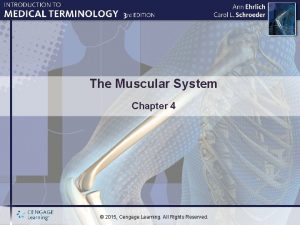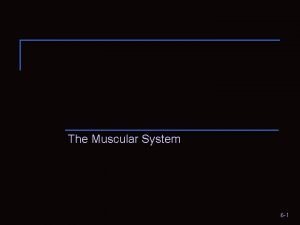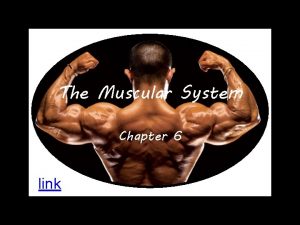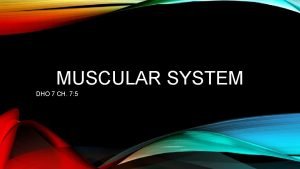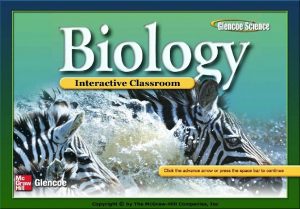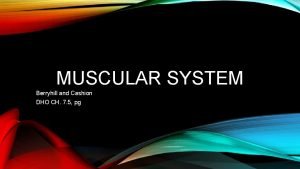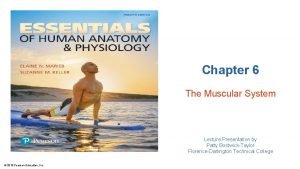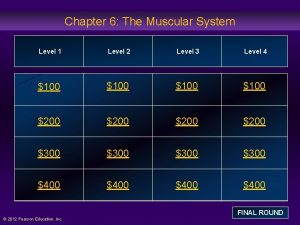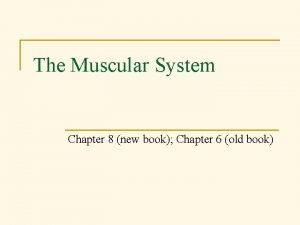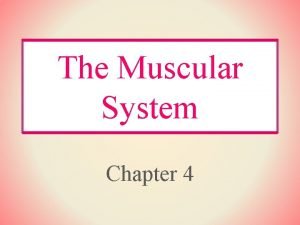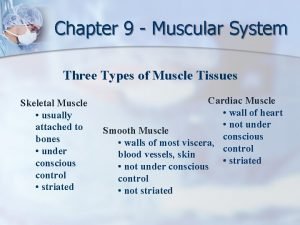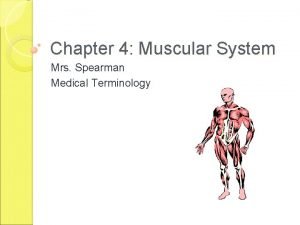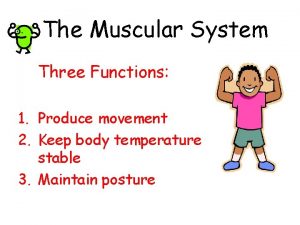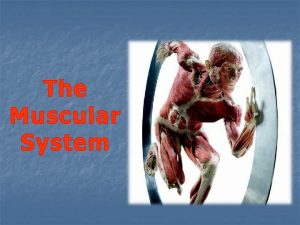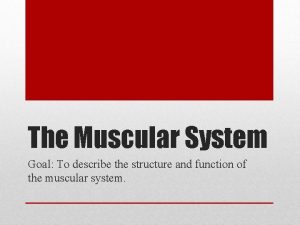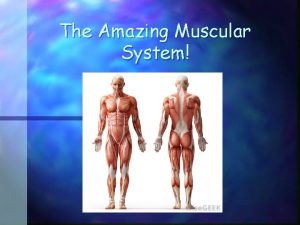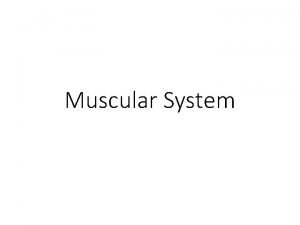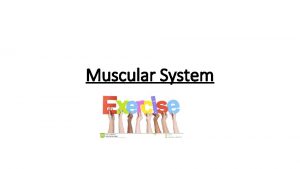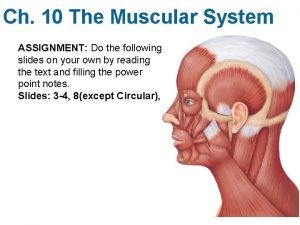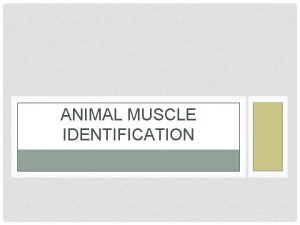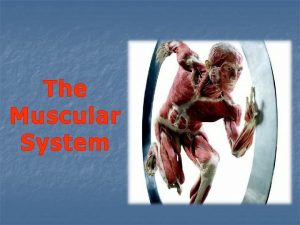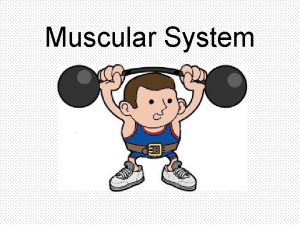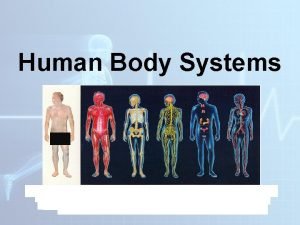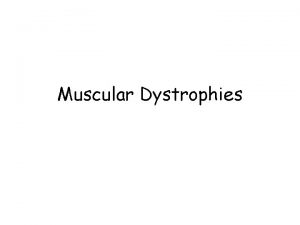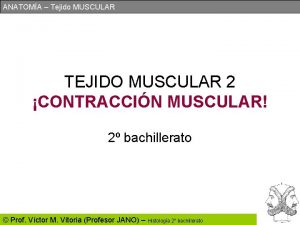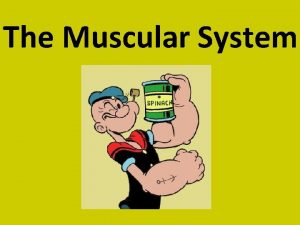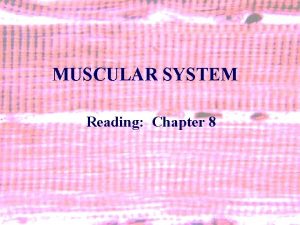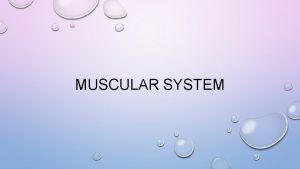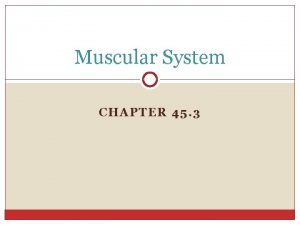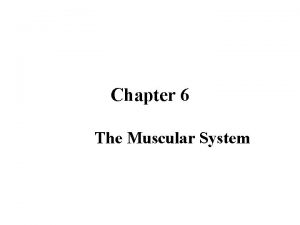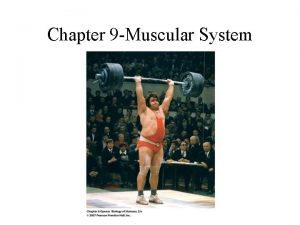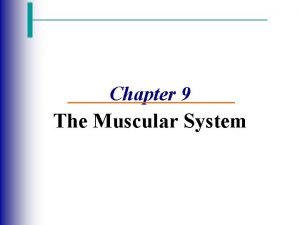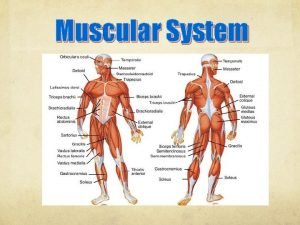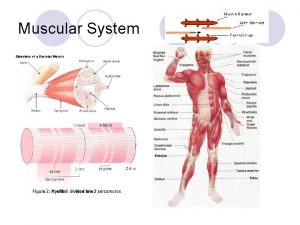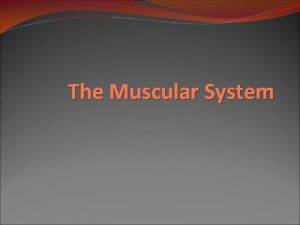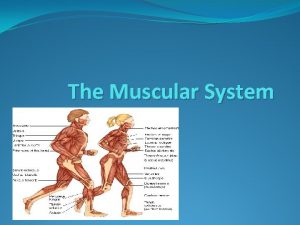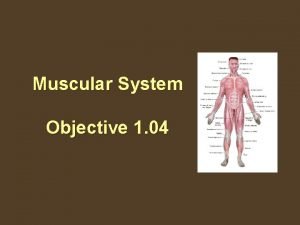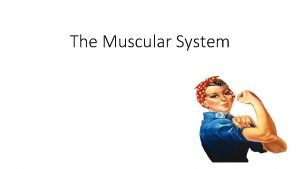Chapter 6 The Muscular System The Muscular System
































- Slides: 32

Chapter 6 The Muscular System

The Muscular System o Muscles are responsible for all types of body movement o Three basic muscle types are found in the body o Skeletal muscle o Cardiac muscle o Smooth muscle

General Characteristics of Muscles o Contraction of muscles is due to the movement of microfilaments o All muscles share some terminology o Prefix myo refers to muscle o Prefix mys refers to muscle o Prefix sarco refers to flesh

Skeletal Muscle Characteristics o Most are attached by tendons to bones o Cells are multinucleate o Striated – have visible banding o Voluntary – subject to conscious control o Cells are surrounded and bundled by connective tissue o Muscle cells are elongated (muscle cell = muscle fiber)

Skeletal Muscle Characteristics l Rapid contraction - not very smooth l Powerful – reports of remarkable strength l Adaptable – different level of contraction strength (strong to delicate) l Tires easily - must rest after short periods of time

Smooth Muscle Characteristics o Has no striations o Spindle-shaped cells o Single nucleus o Involuntary – no conscious control o Found mainly in the walls of hollow organs o Slow smooth contractions

Cardiac Muscle Characteristics o Has striations o Usually has a single nucleus o Joined to another muscle cell at an intercalated disc o Involuntary o Found only in the heart

General Function of Muscles o Produce movement o Maintain posture o Stabilize joints o Generate heat- waste product of using ATP energy

Functional Characteristics l Excitability- ability to receive and respond to stimuli l Contractibility- the ability to shorten forcibly, when enough stimulus is received l Extensibility- ability to be stretched or extended, from a different force. contraction= shorten; relaxation= lengthen l Elasticity- ability to resume shape

Gross Anatomy of Skeletal Muscle l Cells- muscle fiber or myofiber; some muscles may have thousands of myofibers l Blood vessels and nerves- are present. Large amounts of energy is needed. Each muscle is served by at least one artery and vein. l Mitochondria- many present in each cell for extra energy.

Connective Tissue Wrappings of Skeletal Muscle l Endomysium – around single muscle fiber. l Perimysium – around a fascicle (bundle) of fibers.

Connective Tissue Wrappings of Skeletal Muscle l Epimysium – covers the entire skeletal muscle. l Fascia – on the outside of the epimysium. l Tendon- a collection and extension of all 3; used to attach muscle to bone.

Skeletal Muscle Attachments l Epimysium blends into a connective tissue attachment ¡Tendon – cord-like structure ¡Aponeuroses – sheet-like structure l Sites of muscle attachment ¡Bones ¡Cartilages ¡Connective tissue coverings

Arrangement of Fascicles l Fascicle- a muscle bundle made of muscle cells= different shape & function of muscles. ¡ 1. parallel- fascicles run along axis of muscles; greatest movement (bicep) ¡ 2. pennate- short fascicles at an angle to midline of muscle; more strength, less movement (rectus femoris) ¡ 3. convergent- broad origin, narrows to one tendon for connection (pectoralis major) ¡ 4. circular- arranged in a circle surrounding and external opening; opens and closes (orbicularis occuli)

Fascicle Arrangement ¡ 1. parallel ¡ 2. pennate ¡ 3. convergent ¡ 4. circular

Microscopic Anatomy of Skeletal Muscle o Cells are multinucleate o Nuclei are just beneath the sarcolemma

Microscopic Anatomy of Skeletal Muscle o Sarcomere o Contractile unit of a muscle fiber o Made of actin and myosin

Microscopic Anatomy of Skeletal Muscle o Sarcolemma – specialized plasma membrane o Sarcoplasmic reticulum – specialized smooth endoplasmic reticulum

Microscopic Anatomy of Skeletal Muscle o Myofibril o Bundles of myofilaments that run the length of the muscle cell (where contraction occurs) o Myofibrils are aligned to give distinct bands o I band = light band o A band = dark band

Microscopic Anatomy of Skeletal Muscle o Organization of the sarcomere o Thick filaments = myosin filaments o Composed of the protein myosin o Has ATPase enzymes

Microscopic Anatomy of Skeletal Muscle o Organization of the sarcomere o Thin filaments = actin filaments o Composed of the protein actin

Microscopic Anatomy of Skeletal Muscle o Myosin filaments have heads (extensions, or cross bridges) o Myosin and actin overlap somewhat https: //highered. mcgrawhill. com/sites/0072495855/student_view 0/chapter 10 /animation__myofilament_contraction. html

Microscopic Anatomy of Skeletal Muscle o At rest, there is a bare zone that lacks actin filaments o Sarcoplasmic reticulum (SR) – for storage of calcium http: //highered. mcgrawhill. com/sites/0072495855/student_view 0/chapter 10/anim ation__sarcomere_contraction. html

Properties of Skeletal Muscle Activity o Irritability – ability to receive and respond to a stimulus o Contractility – ability to shorten when an adequate stimulus is received

Nerve Stimulus to Muscles o Skeletal muscles must be stimulated by a nerve to contract o Motor unit o One neuron o Muscle cells stimulated by that neuron

Nerve Stimulus to Muscles o Neuromuscular junctions – association site of nerve and muscle

Nerve Stimulus to Muscles o Synaptic cleft – gap between nerve and muscle o Nerve and muscle do not make contact o Area between nerve and muscle is filled with interstitial fluid

Transmission of Nerve Impulse to Muscle o Neurotransmitter – chemical released by nerve upon arrival of nerve impulse o The neurotransmitter for skeletal muscle is acetylcholine o Neurotransmitter attaches to receptors on the sarcolemma o Sarcolemma becomes permeable to sodium (Na+)

Transmission of Nerve Impulse to Muscle o Sodium rushing into the cell generates an action potential o Once started, muscle contraction cannot be stopped

Action Potentials Animation: The Nerve Impulse

The Sliding Filament Theory of Muscle Contraction o Activation by nerve causes myosin heads (crossbridges) to attach to binding sites on the thin filament o Myosin heads then bind to the next site of the thin filament

The Sliding Filament Theory of Muscle Contraction o This continued action causes a sliding of the myosin along the actin o The result is that the muscle is shortened (contracted) o http: //www. cosmolearning. com/vid eos/muscular-system-slidingfilament-theory/
 Differentiate muscular strength from muscular endurance
Differentiate muscular strength from muscular endurance Chapter 4 the muscular system
Chapter 4 the muscular system Chapter 6 the muscular system figure 6-9
Chapter 6 the muscular system figure 6-9 The muscular system chapter 6
The muscular system chapter 6 Chapter 6 the muscular system figure 6-12
Chapter 6 the muscular system figure 6-12 Chapter 7:5 muscular system
Chapter 7:5 muscular system Aerobic respiration exercise
Aerobic respiration exercise Chapter 32 section 3 the muscular system answer key
Chapter 32 section 3 the muscular system answer key Chapter 6 the muscular system figure 6-9
Chapter 6 the muscular system figure 6-9 Chapter 7:5 muscular system
Chapter 7:5 muscular system Chapter 6 the muscular system
Chapter 6 the muscular system Chapter 4 the muscular system labeling exercises
Chapter 4 the muscular system labeling exercises Chapter 6 the muscular system
Chapter 6 the muscular system Chapter 6 the muscular system
Chapter 6 the muscular system Muscles that have their fasciculi arranged like barbs
Muscles that have their fasciculi arranged like barbs Chapter 8 the muscular system
Chapter 8 the muscular system The muscular system chapter 4
The muscular system chapter 4 Active muscle
Active muscle Dyskinesia is the distortion or impairment of:
Dyskinesia is the distortion or impairment of: Chapter 36 skeletal muscular and integumentary systems
Chapter 36 skeletal muscular and integumentary systems Chapter 14 skeletal muscular and nervous systems
Chapter 14 skeletal muscular and nervous systems Three functions of the muscular system
Three functions of the muscular system The rhomboid minor muscle sits __________.
The rhomboid minor muscle sits __________. 4 functions of muscle system
4 functions of muscle system Simple muscular system diagram
Simple muscular system diagram Root word muscle
Root word muscle Muscular system label
Muscular system label Muscular system assignment
Muscular system assignment Brachiocephalicus
Brachiocephalicus Navigating the body regions of the body
Navigating the body regions of the body Whats the function of the muscular system
Whats the function of the muscular system Whats muscular system
Whats muscular system Structures of the muscular system
Structures of the muscular system

